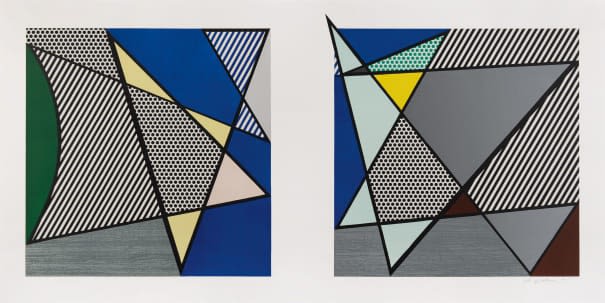
Comic-Book Imagery & the Language of Pop Culture
Lichtenstein's printmaking subjects often revolve around popular culture and the visual language of comic books. He drew inspiration from the comic book aesthetic, incorporating enlarged and stylized images of everyday objects, action scenes, and even text bubbles into his prints. By appropriating these mass-produced images and placing them in the context of fine art, Lichtenstein challenged the traditional boundaries between high and low culture, forcing viewers to reevaluate their perception of art.
Social Commentary Through Irony & Satire
Beyond their visual appeal, Lichtenstein's prints often contained subtle satirical commentary on various aspects of contemporary society. Through the use of irony and wit, he examined consumerism, gender roles, and the superficiality of modern life. Lichtenstein's playful approach to social critique infused his prints with an engaging and thought-provoking quality, encouraging viewers to question the messages embedded within popular culture.
Ben-Day Dots: Lichtenstein’s Signature Technique
One of the most recognizable aspects of Lichtenstein's printmaking is his use of Ben-Day dots, a printing technique commonly used in comic books to create shading and texture. Lichtenstein employed this technique by hand or through stencil methods, carefully applying dots to create the illusion of tone and depth. The result was a visually striking effect that added a distinctive graphic quality to his prints.
Pop Art Colours & Graphic Precision
In addition to Ben-Day dots, Lichtenstein's prints featured bold, flat colours that were characteristic of the Pop Art movement. He used primary colours alongside black and white, evoking a sense of vibrancy and graphic impact. These colour choices heightened the visual impact of his prints, capturing the attention of viewers and reinforcing the connection to popular culture.
Mastery of Silkscreen & Lithography
Lichtenstein utilised various printmaking techniques to achieve his desired visual effects. He frequently employed silkscreen and lithography, both of which allowed him to reproduce his images with precision and consistency. Silkscreen printing enabled him to create clean, sharp lines, while lithography offered a more painterly quality to his prints. Lichtenstein's mastery of these techniques allowed him to achieve the desired flatness and precision characteristic of his style.
Lichtenstein's printmaking also involved experimentation with scale and composition. He often enlarged and isolated particular elements from the source material, emphasising their visual impact and stripping them of their original context. This technique highlighted the graphic quality of his prints and accentuated the commercial aesthetic he sought to explore. By manipulating scale and composition, Lichtenstein challenged conventional notions of representation and encouraged viewers to question the underlying meaning of the images presented.
Roy Lichtenstein's printmaking subjects and techniques played a pivotal role in the development of Pop Art and continue to captivate audiences today. His prints, inspired by popular culture and comic book imagery, served as vehicles for social critique and commentary. Through his use of Ben-Day dots, bold colour palettes, and various printmaking techniques like silkscreen and lithography, Lichtenstein created visually arresting prints that challenged the boundaries of art. By exploring Roy Lichtenstein's printmaking, we gain insight into an artist who brilliantly merged the worlds of high and low culture, leaving an indelible mark on the art world and popular imagination.
Explore our collection of Roy Lichtenstein screenprints for sale or contact Andipa Editions via sales@andipa.com or call +44 (0)20 7589 2371.
